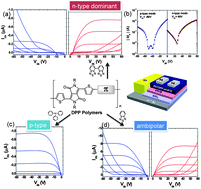Swapping field-effect transistor characteristics in polymeric diketopyrrolopyrrole semiconductors: debut of an electron dominant transporting polymer†
Abstract
A fact-finding study on thiophenyl diketopyrrolopyrrole (TDPP)-containing

* Corresponding authors
a
Interdisciplinary School of Green Energy and KIER-UNIST Advanced Center for Energy, Ulsan National Institute of Science & Technology (UNIST), Ulsan, South Korea
E-mail:
yang@unist.ac.kr
Fax: +82-52-217-2909
Tel: +82-52-217-2920
b Department of Physics and EHSRC, University of Ulsan, Ulsan, South Korea
c Department of Materials Physics, Dong-A University, Busan, South Korea
d Centre for Polymer Science and Engineering, Indian Institute of Technology, Hauz Khas, New Delhi, India
A fact-finding study on thiophenyl diketopyrrolopyrrole (TDPP)-containing

 Please wait while we load your content...
Something went wrong. Try again?
Please wait while we load your content...
Something went wrong. Try again?
J. Lee, S. Cho, J. H. Seo, P. Anant, J. Jacob and C. Yang, J. Mater. Chem., 2012, 22, 1504 DOI: 10.1039/C1JM14549E
To request permission to reproduce material from this article, please go to the Copyright Clearance Center request page.
If you are an author contributing to an RSC publication, you do not need to request permission provided correct acknowledgement is given.
If you are the author of this article, you do not need to request permission to reproduce figures and diagrams provided correct acknowledgement is given. If you want to reproduce the whole article in a third-party publication (excluding your thesis/dissertation for which permission is not required) please go to the Copyright Clearance Center request page.
Read more about how to correctly acknowledge RSC content.
 Fetching data from CrossRef.
Fetching data from CrossRef.
This may take some time to load.
Loading related content
